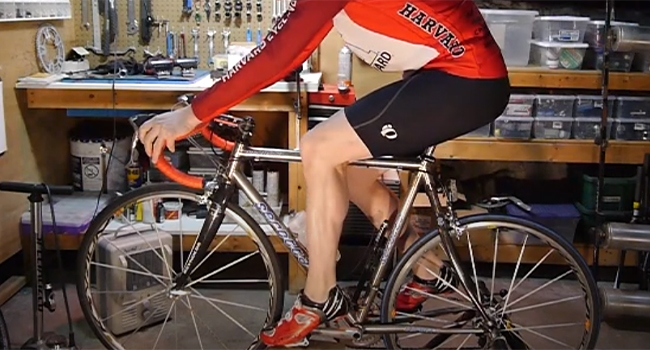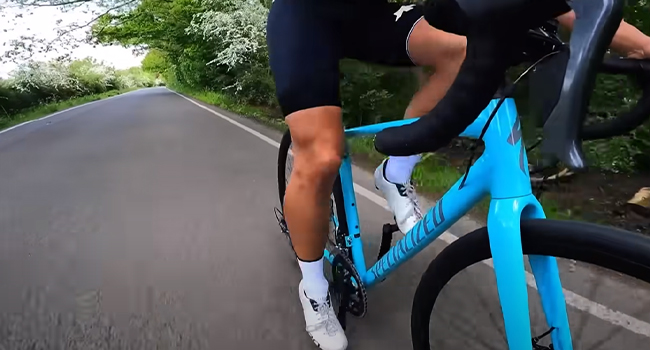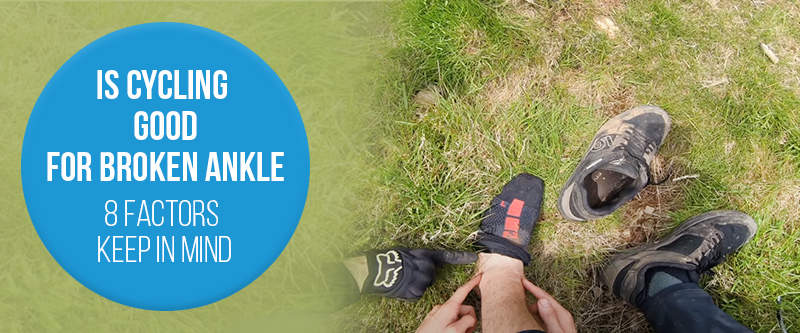After a broken ankle, cycling can apply pressure on the damaged joint, which may exacerbate pain and slow the healing process.
Cycling can lead to complications like nerve or blood vessel damage or bone infections in patients with open fractures. If you plan to cycle during recovery, discuss this with your doctor and take necessary precautions to avoid further harm.
A broken ankle can benefit from stationary cycling once it has rested for at least one week and been cast for at least one week. You should use the bike in its most accessible settings to avoid putting pressure on your ankle.
This blog post will explore whether cycling is good for a broken ankle and factors to consider before cycling with a fractured ankle.
Is Cycling Good For Broken Ankle: 8 Factors To Consider

Cycling can be a great way to stay active and improve cardiovascular health, but if you have a broken ankle, it’s essential to take some precautions before hitting the road. Here are some critical considerations when cycling with a fractured ankle.
Assess Your Injury Severity and Healing Stage
The severity of your injury and the stage of healing required for cycling are essential factors to consider. If you have a severe break involving surgery, you may need to wait a few weeks or months before cycling. If you have a non-displaced fracture, your doctor may allow you to cycle sooner.
Manage Pain and Swelling
Before engaging in any physical activity, adequately manage your pain and swelling. Depending on the severity of your injury, a medical professional may prescribe pain medication. Applying ice and elevating your ankle can also help reduce swelling and pain.
Follow Safety Measures
When cycling with a broken ankle, it is imperative to follow safety measures to avoid further injury. Here are some tips to keep in mind:
- Choose flat, even terrain with no steep hills or rough surfaces.
- Avoid cycling in traffic or crowded areas.
- Wear a protective helmet and cycling shoes.
- Use a pedal with a locking mechanism to keep your foot securely in place.
Choosing the Right Bike and Gear
Ensuring you have the right bike and gear is the first step to cycling with a broken ankle. Here are some things to consider:
- Choose a bike with a low standoff height to make it easier to get on and off.
- Opt for flat pedals to avoid straining your ankle.
- Consider getting a recumbent bike, which will relieve ankle pressure.
- Wear supportive shoes and consider ankle braces or compression socks to help stabilize your ankle.
Avoiding High-affect or Uneven Terrain
Cycling with a broken ankle and avoiding high-affected or uneven terrain that could cause your ankle to twist or turn is essential. Here are some things to keep in mind:
- Stick to smooth paths or roads.
- Avoid hills, stairs, or obstacles that could cause you to lose balance.
- Be mindful of sudden stops or starts that could jolt your ankle.
Exercise Intensity and Duration Gradually Increased

Gradually approaching cycling after breaking an ankle is essential. Here are some tips for increasing your intensity and duration of exercise safely:
- Start with short, simple rides and accumulate the distance and power.
- Alternate cycling with rest days to give your ankle time to heal.
- Listen to your body and stop if you experience pain or discomfort.
Stretching and Physical Therapy Exercises
Cycling is an excellent way to incorporate low-affected exercise into your physical therapy routine. Here are some stretching and physical therapy exercises you can do to help heal your broken ankle:
- Calf stretches.
- Ankle circles.
- Toe curls.
- Resistance band exercises.
- Balance exercises.
Consult Your Doctor
Before engaging in any physical exercise, it’s essential to consult with your doctor. They can assess your injury and give you specific guidelines for cycling with a broken ankle. They may improve your ankle’s range of motion and strength with specific exercises or stretches.
5 Cycling Effects for Broken Ankles
Cycling is often considered a low-affected and effective exercise for individuals recovering from injuries. Understanding the effects of cycling on patients with broken ankles and the potential risks associated with this exercise is essential.
Compartment Syndrome
Compartment syndrome occurs when pressure builds within the muscles, leading to reduced blood flow and subsequent tissue damage. Cyclists with broken ankles may be at increased risk of compartment syndrome, as the foot and ankle muscles are compressed against the bike pedals This can lead to swelling, pain, and muscle weakness that may interfere with recovery.
Nerve or Blood Vessel Damage
Cycling with a broken ankle not only increases the risk of compartment syndrome but also the possibility of nerve or blood vessel damage . The repetitive action of cycling can further harm the injured area, resulting in additional pain and slower healing. Patients with open fractures are more prone to complications as the risk of infection is higher.
Bone Infections
A broken ankle can increase cyclists’ risk of bone infections, as the pressure and movement associated with pedaling can exacerbate the injury. This is especially true for patients with open fractures, where the risk of infection is already elevated.
Malunion of Bones

Cycling can also cause bone malunion in people with ankle fractures. Malunion happens when a broken bone does not heal properly, leading to distortion or other complications.
Arthritis
Cycling has exacerbated arthritis in some people who have suffered from a broken ankle. A joint disorder, arthritis causes inflammation, stiffness, and pain. Cycling can lead to constant pressure or impact on the ankle’s joint surface, leading to arthritis.
Conclusion
Cycling is a great way to improve your physical health and endurance, but as with any exercise, it is essential to consider its potential effects on your body. Suppose you broke an ankle. In that case, it is best to consult your doctor and a physical therapist to determine whether cycling suits your rehabilitation process.
Sometimes, cycling can cause persistent pain, non-union of bones, malunion of bones, arthritis, and lifelong gait abnormalities. By assessing your condition and taking recommendations from a reliable professional, you can enjoy the benefits of cycling while minimizing potential risks.
FAQs
What Not To Do With a Broken Ankle?
- Only put weight on your ankle if your doctor advises you to do so.
- Avoid getting your plaster cast wet.
- Do not carry heavy objects.
- Do not move your ankle excessively.
- Avoid sudden increases in your activity level.
- Do not use improper technique or sports equipment.
- Avoid cluttered or poorly lit areas to prevent falls.
What Exercise Can I Do With a Broken Ankle?
Let’s use the calf muscles as an example. A great way to exercise them is by doing seated heel raises. Once you get comfortable, you can progress to standing double-leg heel raises. After that, you can add weights or do it on one leg. Finally, you can move to plyometrics, which involves hopping and jumping.


